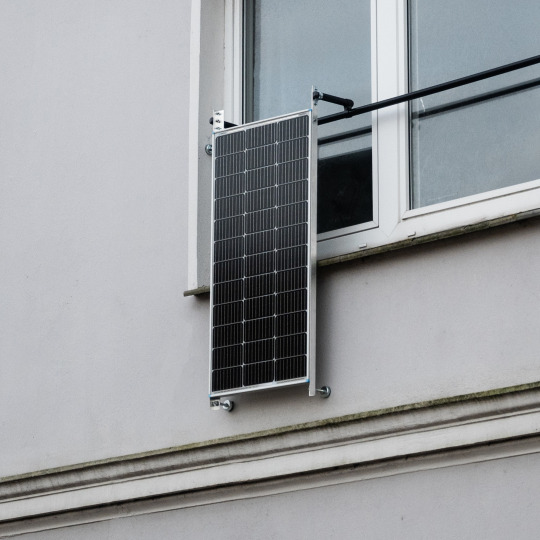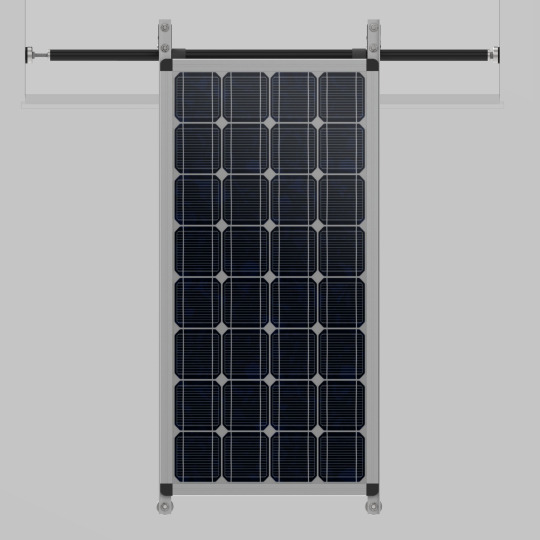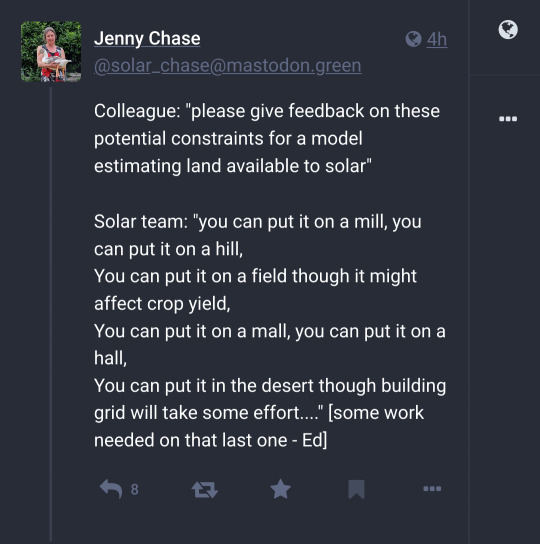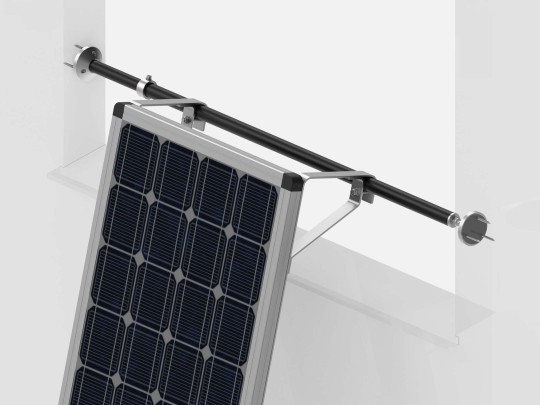#photovoltaics
Photo

Installed photovoltaics capacity per capita in the EU, watts per capita, 2022.
Highest: 🇳🇱Netherlands 1081.5w • Lowest: 🇮🇪Ireland 26.3w
by Maps_interlude
90 notes
·
View notes
Text

Study unlocks nanoscale secrets for designing next-generation solar cells
The work will help researchers tune surface properties of perovskites, a promising alternative and supplement to silicon, for more efficient photovoltaics.
Perovskites, a broad class of compounds with a particular kind of crystal structure, have long been seen as a promising alternative or supplement to today’s silicon or cadmium telluride solar panels. They could be far more lightweight and inexpensive, and could be coated onto virtually any substrate, including paper or flexible plastic that could be rolled up for easy transport.
In their efficiency at converting sunlight to electricity, perovskites are becoming comparable to silicon, whose manufacture still requires long, complex, and energy-intensive processes. One big remaining drawback is longevity: They tend to break down in a matter of months to years, while silicon solar panels can last more than two decades. And their efficiency over large module areas still lags behind silicon. Now, a team of researchers at MIT and several other institutions has revealed ways to optimize efficiency and better control degradation, by engineering the nanoscale structure of perovskite devices.
Read more.
27 notes
·
View notes
Text




I'm living in a flat without balcony on the second floor. I'm not allowed to modify the building stock, like drilling holes into exterior walls. Nonetheless, I want to use solar energy to cover the base load of my flat. Over the last couple months I developed a DIY solution to accomplish just that. A solar panel is clamped into a window embrasure with a telescopic rod. The power is carried through the window into my flat with a special flat conductor.
This is a work in progress, so please visit the project documentation at https://hackaday.io/project/192011-window-mount-for-solar-panels if you are interested.
18 notes
·
View notes
Text



from mastodon
8 notes
·
View notes
Text
Optimizing Your Solar System Year-Round
As the Earth tilts and turns, the changing seasons can have a profound effect on the performance of solar power systems. From the height of summer to the depths of winter, a solar panel owner’s strategy must adapt to ensure their system is optimized throughout the year. Let's take a closer look into how each season affects solar output and how you can maximize your system's efficiency, regardless of the weather.
Summer: Sun’s Out, Panels Out
Summer often means longer days and more direct sunlight, which is excellent news for solar energy production. In the United States, the average solar panel efficiency can climb during these months due to increased insolation – a term that refers to the amount of solar radiation reaching a given area. The Solar Energy Industries Association (SEIA) reports that in peak summer, a well-positioned solar panel system can produce twice as much energy as during winter. However, extreme heat can sometimes decrease panel efficiency, a phenomenon known as temperature coefficient, typically resulting in a performance drop of about 0.5% for every 1°C above 25°C.
Fall: Preparing for the Pivot
As fall approaches, the sun’s angle begins to lower, and days get shorter, which can lead to a decrease in solar production. Despite this, cooler temperatures can enhance panel efficiency, slightly offsetting the loss from reduced daylight. It’s essential to prepare for leaf fall during this season, as debris can obstruct panels and impact performance. A National Renewable Energy Laboratory (NREL) study suggests that a single leaf on a panel can reduce power output by up to 10%.
Winter: Weathering the Cold
Contrary to what many assume, solar panels don't go dormant in winter. They can still produce significant energy, especially in areas with strong winter sunlight. Snow can even act like a mirror, reflecting light and potentially increasing performance on clear days. The key statistic to watch, however, is daylight hours. For instance, according to the U.S. Energy Information Administration (EIA), regions like the Pacific Northwest see a reduction of about 40% in solar radiation from November through February, affecting potential output.
Spring: A Time for Tune-Ups
Spring is often seen as a time of renewal, and for solar panel systems, it's an ideal period for maintenance to optimize energy capture. As days lengthen, your solar system's production will naturally increase. To fully capitalize on this, ensure your system is free from the winter’s accumulation of dirt and debris. Data from the Department of Energy indicates that a clean solar panel is approximately 21% more efficient than one covered in the season’s grime.
Year-Round Maintenance and Monitoring
Regular maintenance is crucial for keeping your solar power system at peak performance. It’s advisable to check your system's output against benchmarks provided by your installer or local averages. Most modern systems come with apps or monitoring software, enabling you to track energy production in real-time and notice any significant discrepancies that may indicate an issue.
Utilizing Battery Storage
To truly optimize your system year-round, consider integrating battery storage. This allows you to capture excess energy during peak production times and use it when the sun isn’t shining. For example, Tesla’s Powerwall reports that, when used effectively, battery storage can increase the self-consumption of solar power from 30% to upwards of 70%.
Embracing Energy Efficiency
Lastly, optimizing a solar system isn’t just about maximizing production; it’s also about minimizing consumption. Implementing energy efficiency measures within your home can significantly impact how much solar power you need to meet your energy demands. The EPA suggests that for every kilowatt-hour of solar energy used efficiently, a typical system’s return on investment can improve by 5-10%.
By understanding and adapting to the seasonal shifts in solar production, you can ensure your system is not only effective but also contributes to a sustainable future all year round. Whether you’re dealing with the abundance of summer sun or the scarcity of winter light, these strategies will help you stay powered through every season.
#solarpanels#solar#solarenergy#photovoltaics#solartechnology#renewables#sustainability#greenenergy#cleanenergy#residentialsolar#solarathome#energyefficiency#solarroi
4 notes
·
View notes
Photo

Contemporary Pool in Cheshire
Idea for a mid-sized contemporary backyard pool house with a rectangular above-ground pool made of decomposed granite.
2 notes
·
View notes
Text
Timeline of Photovoltaic Milestones
1839 Edmond Becquerel discovers the photovoltaic effect.
1873 Willoughby Smith finds that selenium shows photoconductivity.
1883 Charles Fritts creates the first PV solar cell using selenium on a thin layer of gold.
1905 Albert Einstein publishes a paper explaining the photoelectric effect on a quantum basis.
1954 Bell Labs develops the first silicon photovoltaic cell, which is efficient enough to run everyday electrical equipment.
1970's Development of the first cadmium telluride (CdTe) photovoltaic cells.
1985 20% efficiency achieved with silicon cells.
1999 First full-sized thin-film solar panels enter the market.
2009 40% efficiency achieved in laboratory settings.
2021 Perovskite solar cells achieve over 25% efficiency in laboratory conditions.
2024 Commercial-size perovskite tandem cell reaches 28.6% efficiency.
2024 Christoph Putz of Johannes Kepler University, demonstrates energy autonomous drone flight using perovskite solar cells.
Materials Used in PV Cells
Silicon (Si)
The most common material, used in various forms such as monocrystalline, polycrystalline, and amorphous silicon.
Cadmium Telluride (CdTe)
A thin-film material with good efficiency and lower manufacturing costs.
Copper Indium Gallium Selenide (CIGS)
Another thin-film material known for its high absorption efficiency.
Perovskites
A new class of materials that have shown potential for high efficiency and low manufacturing costs.
0 notes
Text
0 notes
Photo

Poolhouse - Poolhouse
Example of a mid-sized trendy backyard decomposed granite and rectangular aboveground pool house design
0 notes
Text
Solar Energy Systems Market Analysis: A Comprehensive Report
The global solar energy systems market size is expected to reach USD 607.8 billion by 2030, according to a new report by Grand View Research, Inc. The industry is expected to grow at a CAGR of 15.7% from 2022 to 2030. Increasing demand for clean and renewable energy production coupled with stringent regulations regarding carbon emissions is expected to boost the industry growth over the forecast period. Governments across the world have started to adopt solar energy for power production due to it being clean and renewable. Many countries have set targets to reduce their carbon emissions and reduce reliance on conventional energy sources by promoting the use of solar energy for power production. The economies of scale achieved due to this increased demand have, in turn, decreased the cost of the components, and product installation viable on a smaller scale.

Solar Energy Systems Market Report Highlights
Various governments have set targets to reduce the carbon emission of countries and have implemented policies to promote the adoption of solar energy systems in the residential sector, which is expected to boost industry growth
The solar panel product segment accounted for the maximum revenue share in 2021. Solar panels are the most complex components in the solar energy systems and received the highest investments for R&D
The utility end-use segment accounted for the maximum revenue share in 2021. Countries all across the world are investing in new utility-scale projects to replace conventional power production
Asia Pacific is projected to grow at the fastest CAGR during the forecast period
East Asia sub-region is expected to account for the maximum share in the Asia Pacific regional market
North America led the industry in 2021 and will continue the trend throughout the forecast years. Solar power accounted for 2.8% of the total electricity generation mix in the U.S. in 2021
For More Details or Sample Copy please visit link @: Solar Energy Systems Market Report
Increasing energy need from emerging economies, such as India, China, and Brazil, is expected to have a positive impact on the industry. The decline in the price of solar energy system components has increased the viability of product installations in residential and commercial sectors. The MRO sector in the industry is expected to grow significantly during the forecast period owing to the increasing adoption of solar energy systems leading to increasing demand for repair and overhaul of existing solar energy systems. Regions, such as Middle East & Africa and Asia Pacific, are expected to have significant growth over the forecast period owing to the high number of investments for solar energy in these regions coupled with rising energy demands. The prices of the components have been declining consistently for the last 10 years and this trend is expected to continue over the forecast period, which, in turn, will fuel the demand in the residential, commercial, and industrial sectors across the globe.
#SolarEnergySystemsMarket#SolarEnergy#RenewableEnergy#CleanTech#SolarPower#Photovoltaics#GreenEnergy#SustainableLiving#EnergyTransition#Renewables#SolarTech#ClimateAction#SolarInnovation#EnergyEfficiency#SolarMarket#Sustainability#SolarPanel#EcoFriendly#FutureEnergy#SolarIndustry#GreenTech
0 notes
Text
Building-integrated photovoltaics (BIPVs) refer to solar power-generating components that are used in constructing facades, roofs, and skylights in buildings. Generally, these components include integration of photovoltaic modules, backup power supply system, charge controller, power storage system, and other supporting hardware. BIPV materials offer several benefits over their traditional counterparts as they provide onsite power generation, zero emissions, high energy conservation, superior architectural integration, and optimal shading. In addition, BIPVs also help in reducing labor and installation costs by replacing high-end roof membranes, skylight glazing, and façade cladding.
0 notes
Text
Challenge: Autonomous Platform for Maintenance Operations in Solar Plants - Technology Org
New Post has been published on https://thedigitalinsider.com/challenge-autonomous-platform-for-maintenance-operations-in-solar-plants-technology-org/
Challenge: Autonomous Platform for Maintenance Operations in Solar Plants - Technology Org


How can we automate maintenance operations systems in solar plants to make harnessing renewable energy more efficient?
A2A, the Seeker of this Challenge, is looking to automate more of the maintenance operations related to the correct functioning of solar photovoltaic (PV) plants. Solvers are asked to create a detailed document about your plans or inform A2A about a system capable of bringing together as many maintenance operations as possible – including both extended and detail operations.
To continue to improve the overall efficiency of A2A’s PV plants, this Challenge asks Solvers to design a layout that will leverage a combination of hardware and software to create an automatic/autonomous system or platform capable of minimizing manual intervention, to become more cost-effective and reliable.
This is a Prize Challenge which requires a written proposal to be submitted. Awards will be contingent upon the theoretical evaluation of the proposal by A2A. For this Prize Challenge, Solvers are required to transfer all rights to the Intellectual Property (IP) in their proposed solution, to be awarded. A2A is willing to consider non-exclusive IP rights for a partial award.
Submissions to this Challenge must be received by 11:59 PM (US Eastern Time) on December 01st, 2023.
Source: Wazoku
You can offer your link to a page which is relevant to the topic of this post.
#2023#challenge#Competitions#december#Design#efficiency#energy#Energy & fuel news#Fundamental physics news#Hardware#how#intellectual property#layout#Link#photovoltaics#plants#pm#renewable#renewable energy#Software#Solar#solar plants#technology#time#transfer
0 notes
Text
The University of Ottawa, together with national and international partners, has achieved a world first by manufacturing the first back-contact micrometric photovoltaic cells.
The cells, with a size twice the thickness of a strand of hair, have significant advantages over conventional solar technologies, reducing electrode-induced shadowing by 95% and potentially lowering energy production costs by up to three times.
The technological breakthrough -- led by Mathieu de Lafontaine, a postdoctoral researcher at the University of Ottawa and a part-time physics professor; and Karin Hinzer, vice-dean, research, and University Research Chair in Photonic Devices for Energy at the Faculty of Engineering -- paves the way for a new era of miniaturization in the field of electronic devices.
Read more.
39 notes
·
View notes
Text




In times of global warming and high energy cost, many wish for taking part in the energy revolution. House owners can mount a photovoltaic system on their roof, balcony owners can hang solar panels from the handrails. However, almost half of the German population lives in flats without balconies. Until now it has not been possible for them to independently produce solar power.
This product concept is a proposed solution to fill this large market niche. To the delight of renters, the building stock is not or barely modified in the process. A telescopic rod is clamped into a window embrasure to hang up a common photovoltaic panel. The electricity is carried to an inverter in the flat using a flat conductor under the window.
4 notes
·
View notes
Text
Poolhouse - Poolhouse

Mid-sized trendy backyard decomposed granite and rectangular aboveground pool house photo
0 notes
Text
Sustainable Living: Integrating Solar Energy into Your Home
Embracing renewable energy is a key step toward sustainable living, and solar energy stands at the forefront of this movement. Homeowners around the globe are harnessing the power of the sun, reducing carbon footprints, and enjoying the economic benefits of solar power. This article delves into the practicalities of integrating solar energy into your home, covering the essentials and the transformative impact it can have on how we live and power our daily lives.
Understanding Solar Energy
Solar energy is captured through photovoltaic (PV) cells that convert sunlight directly into electricity. These cells are assembled into panels, which can be installed on rooftops or in open land areas. When sunlight hits the PV cells, it triggers a flow of electrons, generating direct current (DC) electricity, which is then converted to alternating current (AC) for home use via an inverter.
Assessing Your Solar Potential
Before investing in solar technology, it's crucial to evaluate your home's solar potential. This depends on geographic location, roof orientation, shading from trees or buildings, and local weather conditions. Tools like Google's Project Sunroof or consultations with solar energy providers can offer insights into how much sunlight your rooftop can capture and convert.
Choosing the Right System
There's a range of solar panel systems available, from grid-tied setups that allow you to sell excess power back to the grid, to off-grid systems with battery storage for energy independence. Your choice will hinge on your energy goals, location, and financial considerations. Additionally, solar thermal systems can provide hot water or support heating systems, further reducing reliance on conventional energy sources.
Financial Considerations and Incentives
The initial cost of solar panel installation can be significant, but numerous government incentives, tax breaks, and rebates exist to make it more affordable. Over time, solar panels can pay for themselves through reduced electricity bills. Financing options like solar leases or power purchase agreements (PPAs) can also help homeowners adopt solar energy with little to no upfront costs.
Installation and Maintenance
Professional installation ensures optimal system performance and complies with local codes and regulations. Post-installation, solar panels require minimal maintenance, typically needing only occasional cleaning and checks to ensure no debris or damage. Most solar panels come with long-term warranties, reassuring homeowners of their durability and efficiency.
Environmental Impact
Integrating solar energy into your home is a positive step for the environment. It reduces reliance on fossil fuels, curtails greenhouse gas emissions, and contributes to a decrease in air pollution. As residential solar energy use grows, it aids in the collective effort to combat climate change and promotes a healthier planet.
Looking Ahead
Solar energy technology continues to advance, with improvements in efficiency, aesthetics, and integration with smart home technologies. As battery storage solutions become more affordable, the ability to store and manage energy will revolutionize home solar systems. By integrating solar energy into your home today, you're not just saving on costs but also investing in a sustainable future and joining the vanguard of the renewable energy revolution.
#solarpanels#solar#solarenergy#photovoltaics#solartechnology#renewables#sustainability#greenenergy#cleanenergy#residentialsolar
3 notes
·
View notes